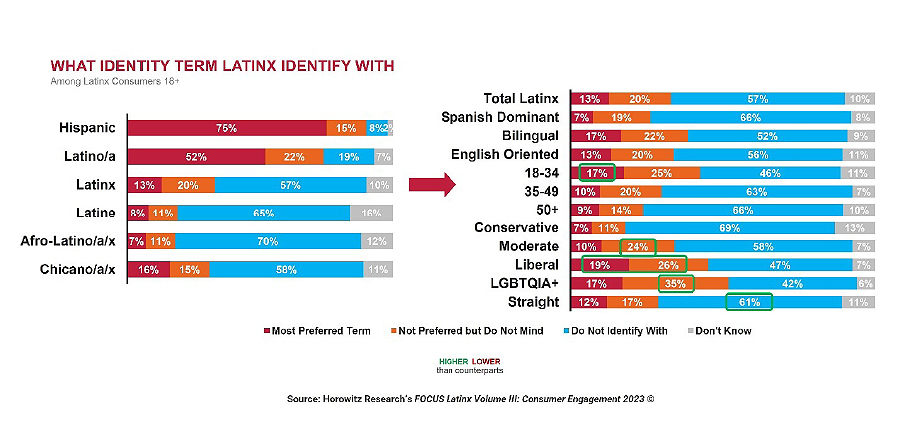Not a day goes by when a client doesn’t ask us to opinionate about whether they should use the terms “Latinx” or “Latine” when addressing the Hispanic market. In fact, many other marketers, research companies, and even think tanks like Pew have weighed in on this question.
by Adriana Waterston
I thought it was time to offer some historical, linguistic, and cultural context to this debate, share my viewpoint on the use of these terms, and provide some guidance as to when and why either of these terms should be used, or not.
Let’s start with some context.
The evolution of the terms Latinx/Latine to refer to Hispanic or Latino* people is not a unique phenomenon that only touches the United States, nor was it created for or by U.S.-based Hispanic marketers. It stems from a broader international, global movement to de-gender language because gendered language—such as the default use of the masculine word Latino to represent “all Latinos”—stems from, and helps reinforce, patriarchal structures that silence and make invisible the voices, experiences, and contributions of women and completely exclude other gender identities and non-binary people. In terms of Spanish, the trend actually started in Argentina, led by young female and LGBTQIA+ activists. There are similar movements to de-gender other languages, including Hebrew and German.
The reality is that all languages are always in flux and ever-changing. We all know there are words and terms in the dictionary today that didn’t exist even a few years ago (Spam? Googling? Girlboss?). Language is an expression of culture and society and will always change and morph along with it. For example, when it comes to gender and language, over the past decades the term “Dear Sirs” in business has disappeared because it became socially unacceptable as more women entered the workplace. Similarly, as it relates to racialized structures and language, most of us do not use the term “master bedroom” anymore, as it refers to a time when there were masters and there were slaves. Increasingly, we see the more accurate and contemporary phrase “primary bedroom.”
Now, we are at the nexus of three important social and cultural trends happening at once: First, we are more aware than ever of the power of language to uphold systems of power overall. This is why in our polarized times, the question of who controls narratives and frames arguments is so important (e.g., is being “woke” a good thing or a bad thing? Who is allowed to “say gay?” Are you pro-life or pro-choice?). Second, there is more equality than ever for women and girls in the classroom, workplace, boardroom, and political chambers (despite the fact that we still do not have an Equal Rights Amendment). And third, there is a growing understanding that gender really exists on a spectrum rather than as a binary (male/female), and growing awareness that there are many people in our society for whom neither the “female” or “male” of any language fits.
Qualitatively, as well as quantitatively, we have seen in our research and others that there are many Latine young people who are choosing to use de-gendered forms of the language. It is important to understand that the desire to de-gender language is not just about de-gendering that one word “Latino.” It is also about using non-gendered versions of many words that are gendered. For example, using the terms “amigues” instead of “amigos or amigas”, “niñe” instead of “niño or niña” or even the pronoun “elle” instead of “el or ella.”
This trend has, not surprisingly, been met with outrage, especially by more conservative folks who see the desire to de-gender the Spanish language as some sort of aberration or insult to “real Spanish.” I believe it is important to be a little cynical and question who is pushing the narrative that de-gendering the language is a bad thing. In other countries where there is a movement to de-gender language, similar outrage has ensued (a Google search of the issue leads to some very interesting articles like this one or this one). It is worth asking why certain people are so against language that encourages equality and inclusion. Let’s be real: The fabricated outrage of certain people against the de-gendered terms go hand in hand with the “anti-woke” agenda attempting to quash DEI initiatives, ban books, take women’s right to bodily autonomy away, and put LGBTQIA+ Americans back in the closet.
My point of view: Should you adopt Latinx or Latine? If so, which one?
Some people point to research that seems to indicate that U.S. Hispanics overwhelmingly prefer the standard terms Hispanic or Latino and reject the newer terms Latinx or Latine. In my view, this should not be surprising or even considered an important finding. Why?
Of course, more people prefer the terms Hispanic or Latino than prefer Latinx or Latine. In fact, I would be suspicious if any research suggested otherwise, because these terms have been around for decades. Language doesn’t change that quickly. In fact, it took a while for the term Hispanic, which first started being used in the 1970s, to be embraced: https://www.latinousa.org/2015/05/22/the-invention-of-hispanics/
To me, a parallel would be the following: Imagine if there were a movement to stop people from the United States as identifying as “American” because, really, they aren’t the only Americans, right? There are South Americans, Central Americans, Caribbean Americans, North Americans who we call Canadians, etc. Why does the United States get the exclusive right to use this term? We do not “own” that identity. It stems, of course, from our colonial history. Imagine if a new movement forms to convince people to start saying “United Statesians” instead of “Americans.” It would take decades, generations, for this to stick, as the term grows in understanding, usage, and acceptance. And, it would likely be met with similar backlash. So why should we be surprised that it will take generations or at least decades to fully see how the Spanish language, and any language that is gendered, evolves to be more inclusive?
Now, let’s talk about the research that’s out there. We know about the articles and data that suggest that “people don’t like the term,” but a lot has to do with how it is asked. To be honest, many researchers do a sloppy job of asking about it. Of course, if you present Hispanic, Latino, or Latinx/Latine to people and ask them to choose the ONE they most identify with, the two more common terms will be selected the most, for the reasons we describe above. You simply can’t compare the appeal/comfort with a term that has been around for generations, like Hispanic or Latino, to how comfortable someone would be to a term that is brand new, especially given the context of the propaganda against the usage of Latinx or Latine.
Let’s look at the data.
At Horowitz, we started asking about acceptance of these words in our surveys since 2018, but we handle the question in a different way than most research companies do. We ask participants to rate ALL of the terms: Hispanic, Latino, Latinx, Latine, etc. For each term, participants tell us whether it is “the term they prefer,” “a term they don’t mind (but don’t prefer it),” “a term they do not identify with,” or they can answer “don’t know.”
In our most recent report, about 1 in 3 (33%) either prefer the term Latinx or do not mind it, and additionally, 19% also said they prefer or do not mind “Latine.” Moreover, there are HUGE differences by age, acculturation, and political orientation. Not surprisingly, younger, more liberal, and LGBTQIA+ Hispanic/Latinx/e are more likely to say they identify the most with Latinx than their older, more conservative counterparts.

Clearly, the decision to use these terms varies greatly depending on the circumstance. So what should you do?
In my view, right now, the decision to use or not use Latinx, Latine, etc., as the term for “Latinos” or “Hispanics” needs to be considered from various angles.
- One would be the angle of how one personally identifies and the term one personally prefers to describe oneself and their community. There are a lot of Hispanic/Latinx/Latine people in the U.S. and elsewhere who do not connect with the term Latinx or Latine, who do not want to use it to describe themselves or the community, and perhaps believe, as the narrative out there suggests, that it is an insult to the language, etc. Many older Latinos fall into this category. It is important to know that no one is forcing people to change the identity and language choice they prefer and are most comfortable using for themselves or their community, even if that language choice is hurtful to or exclusive of a growing number of people in our community. As a Latina myself, I personally choose to use the more inclusive terms to refer to our community because that more accurately reflects my personal experience and the experiences of my friends and family.
- Another would be the angle of the marketer, who must ask—especially when creating messaging, marketing, and ad copy—“Who am I targeting within the Hispanic/Latinx/Latine market? What do the majority of that group I am targeting prefer?” This is a business and stylistic choice and there is no one “right way” to approach this. Generally, many marketers feel that when targeting older, less acculturated people, they should use more traditional terminology; while if they are targeting younger, bicultural folks, the term Latinx or Latine is a smarter choice. We would tend to agree with this pragmatic approach but would encourage marketers and their clients to do custom research with a research company that is well-versed in cultural nuances to truly understand the pros and cons of using, or not using the terms based on their particular target market.
- There is also the angle of the researcher. As researchers, it is important to think carefully about the language we use in our surveys that could exclude or include people, turn people off or on, and potentially skew the results of our research. We want to make sure our surveys are a safe place where all respondents feel their voice matters. This is why, whenever possible (and of course, thinking about who the target of the survey is), we like to use language that signals that everyone is welcome to take our survey. When possible, asking people their preferred term can allow us to correctly pipe references to Hispanic/Latinx/Latine identity where relevant throughout the survey to ensure the quality of the research results.
- And then there is the angle of how a corporate entity chooses to use language, to signal inclusivity. Beyond my personal communications, in the communications that Horowitz creates, we have chosen to embrace gender-neutral language to the best of our ability. Besides the fact that 99% of the Horowitz staff is female, we also have non-binary employees and family members. We study LGBTQIA+ and Gen Z audiences, along with the total market consumers we work with. We make an effort to be as gender-neutral and inclusive in our communications as possible. We strongly encourage our employees to share their pronouns and ask others their pronouns, and we choose to use the term Latinx or Latine, as well as other gender-neutral forms of Spanish words, whenever possible, because we believe that modeling this is an important part of normalizing the conversation about the role of language in conversations about equality.
At Horowitz, we have started using Latinx and Latine interchangeably, although now we are skewing towards Latine as it is easier to pronounce in Spanish. Overall, it will take a long time to really see how adoption of these terms evolve.
We understand this is a challenging issue and not one that can be easily solved with black-and-white answers. We look forward to working with you to provide you our best, data and insights-driven advice on how to best reach and resonate with today’s Latine audiences.
*For the sake of this article, I am not distinguishing between Hispanics (people who hail from Spanish-speaking countries) and Latinos/as/x/es (people whose origins are from Latin America or the Caribbean—we can save that for a different day!)
The full FOCUS Latinx: State of Media, Entertainment & Tech: Consumer Engagement 2023 report explores different segments of Latinx consumers and their attitudes towards hot-button topics to help media companies, advertisers, advertising/marketing agencies, and PR companies make smart decisions about Latinx marketing and outreach. The survey was conducted in August 2023 among 606 Latinx adults 18+. Data have been weighted to ensure results are representative of the overall U.S. Latinx population. The report is available in total market, FOCUS Latinx, FOCUS Black, and FOCUS Asian editions.
ABOUT HOROWITZ RESEARCH DIVISION OF M/A/R/C RESEARCH
Horowitz Research is a leading provider of consumer market research specializing in consumers and their relationships to media, content, and technology with a particular expertise in cultural insights among America’s Black, Latinx, Asian, LGBTQIA+, and Gen Z audiences. The company offers a full suite of à la carte syndicated reports as well as custom quantitative and qualitative consumer research for companies ranging from small start-ups to Fortune 500. Horowitz Research was recently acquired by M/A/R/C Research, a Texas-based research and insights firm. For more information, visit www.horowitzresearch.com.

Adriana Waterston is an Executive Vice President and Insights & Strategy Lead at Horowitz Research. A thought leader in the diversity space, Adriana has consulted for clients in entertainment and news media, technology and telecommunications, travel and hospitality, CPG, retail, toys, beauty and personal care, and the emerging cannabis market, among others.
Photo by Manny Becerra on Unsplash













